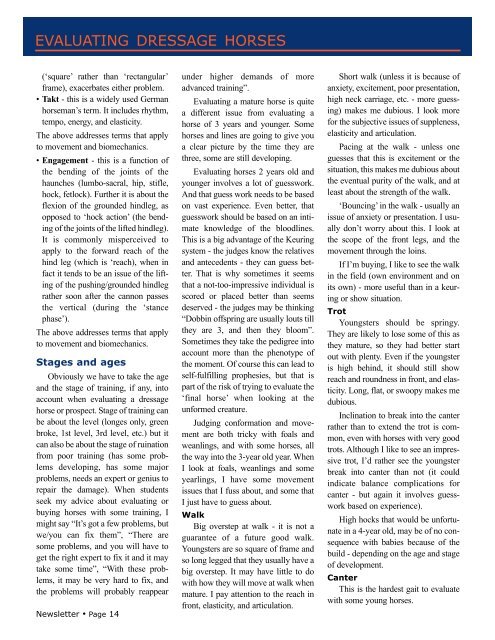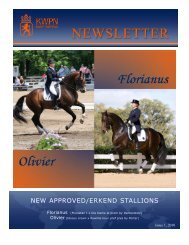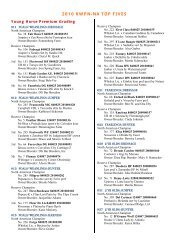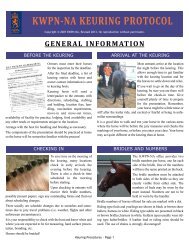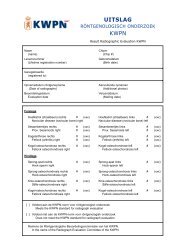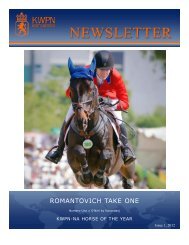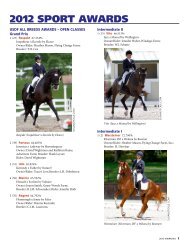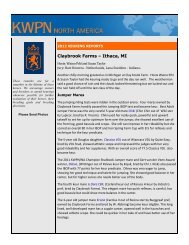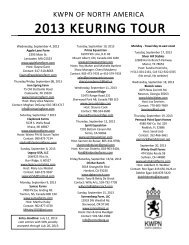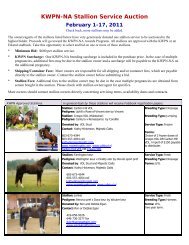Download PDF - KWPN
Download PDF - KWPN
Download PDF - KWPN
You also want an ePaper? Increase the reach of your titles
YUMPU automatically turns print PDFs into web optimized ePapers that Google loves.
EVALUATING DRESSAGE HORSES<br />
(‘square’ rather than ‘rectangular’<br />
frame), exacerbates either problem.<br />
• Takt - this is a widely used German<br />
horseman’s term. It includes rhythm,<br />
tempo, energy, and elasticity.<br />
The above addresses terms that apply<br />
to movement and biomechanics.<br />
• Engagement - this is a function of<br />
the bending of the joints of the<br />
haunches (lumbo-sacral, hip, stifle,<br />
hock, fetlock). Further it is about the<br />
flexion of the grounded hindleg, as<br />
opposed to ‘hock action’ (the bending<br />
of the joints of the lifted hindleg).<br />
It is commonly misperceived to<br />
apply to the forward reach of the<br />
hind leg (which is ‘reach), when in<br />
fact it tends to be an issue of the lifting<br />
of the pushing/grounded hindleg<br />
rather soon after the cannon passes<br />
the vertical (during the ‘stance<br />
phase’).<br />
The above addresses terms that apply<br />
to movement and biomechanics.<br />
Stages and ages<br />
Obviously we have to take the age<br />
and the stage of training, if any, into<br />
account when evaluating a dressage<br />
horse or prospect. Stage of training can<br />
be about the level (longes only, green<br />
broke, 1st level, 3rd level, etc.) but it<br />
can also be about the stage of ruination<br />
from poor training (has some problems<br />
developing, has some major<br />
problems, needs an expert or genius to<br />
repair the damage). When students<br />
seek my advice about evaluating or<br />
buying horses with some training, I<br />
might say “It’s got a few problems, but<br />
we/you can fix them”, “There are<br />
some problems, and you will have to<br />
get the right expert to fix it and it may<br />
take some time”, “With these problems,<br />
it may be very hard to fix, and<br />
the problems will probably reappear<br />
Newsletter • Page 14<br />
under higher demands of more<br />
advanced training”.<br />
Evaluating a mature horse is quite<br />
a different issue from evaluating a<br />
horse of 3 years and younger. Some<br />
horses and lines are going to give you<br />
a clear picture by the time they are<br />
three, some are still developing.<br />
Evaluating horses 2 years old and<br />
younger involves a lot of guesswork.<br />
And that guess work needs to be based<br />
on vast experience. Even better, that<br />
guesswork should be based on an intimate<br />
knowledge of the bloodlines.<br />
This is a big advantage of the Keuring<br />
system - the judges know the relatives<br />
and antecedents - they can guess better.<br />
That is why sometimes it seems<br />
that a not-too-impressive individual is<br />
scored or placed better than seems<br />
deserved - the judges may be thinking<br />
“Dobbin offspring are usually louts till<br />
they are 3, and then they bloom”.<br />
Sometimes they take the pedigree into<br />
account more than the phenotype of<br />
the moment. Of course this can lead to<br />
self-fulfilling prophesies, but that is<br />
part of the risk of trying to evaluate the<br />
‘final horse’ when looking at the<br />
unformed creature.<br />
Judging conformation and movement<br />
are both tricky with foals and<br />
weanlings, and with some horses, all<br />
the way into the 3-year old year. When<br />
I look at foals, weanlings and some<br />
yearlings, I have some movement<br />
issues that I fuss about, and some that<br />
I just have to guess about.<br />
Walk<br />
Big overstep at walk - it is not a<br />
guarantee of a future good walk.<br />
Youngsters are so square of frame and<br />
so long legged that they usually have a<br />
big overstep. It may have little to do<br />
with how they will move at walk when<br />
mature. I pay attention to the reach in<br />
front, elasticity, and articulation.<br />
Short walk (unless it is because of<br />
anxiety, excitement, poor presentation,<br />
high neck carriage, etc. - more guessing)<br />
makes me dubious. I look more<br />
for the subjective issues of suppleness,<br />
elasticity and articulation.<br />
Pacing at the walk - unless one<br />
guesses that this is excitement or the<br />
situation, this makes me dubious about<br />
the eventual purity of the walk, and at<br />
least about the strength of the walk.<br />
‘Bouncing’ in the walk - usually an<br />
issue of anxiety or presentation. I usually<br />
don’t worry about this. I look at<br />
the scope of the front legs, and the<br />
movement through the loins.<br />
If I’m buying, I like to see the walk<br />
in the field (own environment and on<br />
its own) - more useful than in a keuring<br />
or show situation.<br />
Trot<br />
Youngsters should be springy.<br />
They are likely to lose some of this as<br />
they mature, so they had better start<br />
out with plenty. Even if the youngster<br />
is high behind, it should still show<br />
reach and roundness in front, and elasticity.<br />
Long, flat, or swoopy makes me<br />
dubious.<br />
Inclination to break into the canter<br />
rather than to extend the trot is common,<br />
even with horses with very good<br />
trots. Although I like to see an impressive<br />
trot, I’d rather see the youngster<br />
break into canter than not (it could<br />
indicate balance complications for<br />
canter - but again it involves guesswork<br />
based on experience).<br />
High hocks that would be unfortunate<br />
in a 4-year old, may be of no consequence<br />
with babies because of the<br />
build - depending on the age and stage<br />
of development.<br />
Canter<br />
This is the hardest gait to evaluate<br />
with some young horses.


